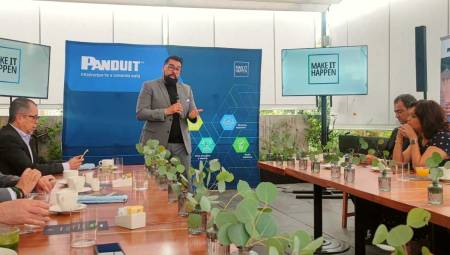Latin America. Technology continues to evolve at an unprecedented rate, and predictions about upcoming trends are always up for debate: what's real and what's exaggerated.
While there's always a flurry of excitement around the next big thing, I think the past year has been different. Advances in AI, especially generative AI (GenAI), are leading to extraordinary change in a generation. This is opening up huge new opportunities and transforming industries, modes of operation and career paths.
Cisco's AI Readiness Index revealed that 95% of respondents have an AI strategy in place or in development, but only 14% are fully prepared to integrate AI into their business. What does it take for businesses to adopt and integrate AI? How can innovators take advantage of change to remain competitive? Where and how will innovation and trust intersect?
These insights and questions have inspired my predictions for upcoming tech trends in 2024.
1. GenAI will rapidly expand in the enterprise world with GenAI-powered NLIs, custom LLMs, bespoke B2B applications, and business context.
GenAI-powered natural language interfaces (NLIs) will be expected for new products and more than half will have them by default by the end of 2024. GenAI will also be leveraged in B2B interactions with users who demand more contextualized, personalized, and integrated solutions. GenAI will provide APIs, interfaces, and services for accessing, analyzing, and visualizing data and insights, and will be generalized in areas such as project management, software quality and testing, conformance assessments, and recruitment. As a result, the visibility of AI will increase.
We will also witness the rise of specialized, domain-specific AI models and a shift towards smaller, more specialized LLMs with higher levels of accuracy, relevance, precision, and understanding of domain niches. For example, LLaMA-7B models – often used for code completion and few-shotting – will be increasingly adopted. In addition, the multimodal combination of various types of data, such as images, text, speech, and numerical data, with intelligent processing algorithms will expand B2B use cases. This will lead to better results in areas such as business planning, medicine and financial services.
2. A movement for the responsible and ethical use of AI will start with clear AI governance frameworks that respect human rights and values.
AI adoption is an extraordinary technological shift in a generation and sits at the intersection of innovation and trust. However, 76% of companies do not have comprehensive AI policies in place. Overall, we agree that we need regulations/policies and industry self-control and governance to mitigate the risks of GenAI. However, we need to be more nuanced, for example, in areas such as intellectual property infringement, where fragments of original artworks are extracted to generate new digital art. This area needs regulation.
We must also ensure that consumers have access to and control over their data in the context of the recent EU Data Act. With the growing importance of AI systems, publicly available data will soon peak and high-quality language data is likely to run out before 2026. Organizations have to switch to private and/or synthetic data, which opens up the possibility of unintended access and use.
Companies can do a lot on their own. Leaders must commit to transparency and reliability around the development, use, and outcomes of AI systems. For example, in terms of reliability, organizations should address false content and unintended outcomes with RAI assessments, robust LLM training to reduce the possibility of hallucinations, sentiment analysis, and outcome modeling. In 2024, we will see companies of all sizes and industries formally describe how responsible AI governance guides the internal development, application, and use of AI. Until tech companies can credibly demonstrate that they are trustworthy, governments will create more policies.
3. Consumers and businesses will face increased risks from AI-generated misinformation, scams, and fraud, prompting tech companies and governments to collaborate to find solutions.
AI-enabled misinformation, scams, and fraud will continue to grow in 2024 as a threat to businesses, individuals, and even candidates and elections. In response, we will see more investments in risk detection and mitigation. New inclusive AI solutions will protect against cloned voices, deepfakes, social media bots, and influencer campaigns. AI models will be trained on large data sets to improve their accuracy and efficiency. The new authentication and provenance mechanisms will promote transparency and accountability.
In line with the G7 Guiding Principles on AI in relation to threats to democratic values, the Biden Administration's Executive Order on Safe AI, and the EU AI Act, we will also see more collaboration between the private sector and governments to raise threat awareness and implement verification and security measures. We will see cooperation to sanction rogue actors and ensure regulatory compliance. Enterprises should prioritize advanced threat detection and data protection, regular vulnerability assessment, updating security systems, and thorough audits of network infrastructures. For consumers, vigilance will be key to protecting their identity, savings, and credit.
4. Quantum breakthroughs, but not quantum leaps, this is how the future of cryptography and networking will continue to take shape.
We will witness the adoption of post-quantum cryptography (PQC) – even before it is standardised – as a software-based approach that works with conventional systems to protect data from future quantum attacks. PQC will be adopted by browsers, operating systems, and libraries, and innovators will experiment with integrating it into protocols such as SSL/TLS 1.3, which governs classical cryptography. PQC will also start to reach enterprises, which will try to ensure data security in the post-quantum world.
Another trend will be the growing importance of quantum networks, which in 4 or 5 years – perhaps longer – will allow quantum computers to communicate and collaborate to achieve more scalable quantum solutions. Quantum networks will take advantage of quantum phenomena such as entanglement and superposition to transmit information. QKD, as an alternative or complement to PQC depending on the level of security and performance required, will also take advantage of quantum networks. Public administrations and financial services, which are very demanding in terms of security and data processing, will make significant investments and research in quantum networks.
5. To unlock the future of AI-powered personalization, businesses will embrace the power and potential of API abstraction.
Companies this year will be looking for innovative ways to harness the immense power and advantages of AI without the complexity and cost of building their own platforms. Application programming interfaces (APIs) will play a critical role. APIs will increasingly act as an "abstraction layer," seamless bridges that will integrate a multitude of pre-built AI tools, services, and systems with little development configuration or infrastructure. With access to a wide range of AI capabilities through APIs, teams will automate repetitive tasks, gain deeper insights into data, and improve decision-making.
This year will also mark the beginning of a race towards API-driven personalization, in which companies will be able to choose and combine APIs from multiple vendors, easily adapting AI solutions to meet unique and novel requirements. Flexibility and scalability will foster effortless collaboration with external AI experts, startups, and research institutions, driving an exchange of ideas and breakthroughs. In fact, these "model garden" ecosystems are already taking shape and in 2024 we will see them really take off.
6. AI can't be greenwashed: Advancements will further drive energy use while unlocking new networking and energy efficiency paradigms.
Sustainable energy plays a vital role in the fight against climate change. By selecting smaller AI models, with fewer layers and specific filters for use cases, companies will begin to reduce energy consumption costs compared to general systems. These dedicated systems are prepared with smaller, highly accurate data sets and efficiently perform specific tasks. Deep learning models, on the other hand, use large amounts of data.
The emerging category of power grids, which combines the capabilities of software-defined grids and an electric power system made up of direct current microgrids, will also contribute to energy efficiency. By applying grids to energy and connecting them to data, energy grids offer complete visibility and benchmarking of existing emissions, as well as an access point to optimize energy use, distribution, transmission, and storage. Energy grids will also help organizations measure energy use and emissions more accurately, automate many functions in IT, smart buildings, and IoT sensors, and unlock inefficient and unused energy. With integrated energy management capabilities, the grid will become a control plane for measuring, monitoring and managing consumption
7. 'The 'left turn' will translate into collaboration, modern converged platforms, and a little help from AI, to reveal a new programming experience... and better software.
As organizations continue to "turn left," software development will change with new tools, approaches, and technologies. Programmers will leverage platforms and collaboration—and even a little help from AI—to centralize toolsets and unlock newfound efficiencies so they can focus on delivering exceptional digital experiences. For example, they will use CNAPP, Cloud Security Posture Management (CSPM), and Cloud Workload Protection Platforms (CWPP) to combat tool proliferation, streamline workflows, and remove the burden of managing disjointed tools.
Some will continue to struggle with disparate point solutions, leaving security loopholes and software supply chain issues. Innovators will use AI to speed up delivery and manage tedious tasks such as defect and error testing. Along the way, collaboration tools and AI assistants will be trusted companions as teams tackle the complexities of security, visibility, and infrastructure. They will also use AI-derived insights to navigate the complexities of components, protocols, and tools. Human checks and balances must ensure that AI-based decisions are fair, impartial, and in line with ethical and moral values. We believe that AI should augment human decision-making, not replace it entirely.
AI has emerged as a catalyst and canvas for the future. It's already in our homes, our cars, our offices... and in our pockets. While we marvel at the progress made in a short period of time, we must also weigh the benefits and risks.
Trust between people and the AI systems and tools they use is critical and non-negotiable. This means clarifying what AI can and cannot do with new frameworks of data transparency and accountability, new efforts to educate people and businesses about how disruption might occur, teach the skills that will be needed for new AI-enabled jobs, and new ways to collaborate with people's interests in mind.
It's an exciting time. I look to 2024 with a feeling of optimism and admiration based on my deep conviction that trust is the necessary ingredient for any new wave of technology to take hold. What's good for the world is good for business. Together, let's advance the promise of AI with confidence.
Analysis by Liz Centoni, Chief Strategy Officer & GM, Applications at Cisco.
















